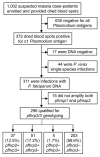Plasmodium falciparum pfhrp2 and pfhrp3 Gene Deletions and Relatedness to Other Global Isolates, Djibouti, 2019-2020
- PMID: 36148905
- PMCID: PMC9514350
- DOI: 10.3201/eid2810.220695
Plasmodium falciparum pfhrp2 and pfhrp3 Gene Deletions and Relatedness to Other Global Isolates, Djibouti, 2019-2020
Abstract
Deletions of pfhrp2 and paralogue pfhrp3 (pfhrp2/3) genes threaten Plasmodium falciparum diagnosis by rapid diagnostic test. We examined 1,002 samples from suspected malaria patients in Djibouti City, Djibouti, to investigate pfhrp2/3 deletions. We performed assays for Plasmodium antigen carriage, pfhrp2/3 genotyping, and sequencing for 7 neutral microsatellites to assess relatedness. By PCR assay, 311 (31.0%) samples tested positive for P. falciparum infection, and 296 (95.2%) were successfully genotyped; 37 (12.5%) samples were pfhrp2+/pfhrp3+, 51 (17.2%) were pfhrp2+/pfhrp3-, 5 (1.7%) were pfhrp2-/pfhrp3+, and 203 (68.6%) were pfhrp2-/pfhrp3-. Histidine-rich protein 2/3 antigen concentrations were reduced with corresponding gene deletions. Djibouti P. falciparum is closely related to Ethiopia and Eritrea parasites (pairwise GST 0.68 [Ethiopia] and 0.77 [Eritrea]). P. falciparum with deletions in pfhrp2/3 genes were highly prevalent in Djibouti City in 2019-2020; they appear to have arisen de novo within the Horn of Africa and have not been imported.
Keywords: Djibouti; Plasmodium falciparum; malaria; parasite relatedness; parasites; pfhrp2; pfhrp3; vector-borne infections.
Figures




Similar articles
-
Misdiagnosis of imported falciparum malaria from African areas due to an increased prevalence of pfhrp2/pfhrp3 gene deletion: the Djibouti case.Emerg Microbes Infect. 2020 Dec;9(1):1984-1987. doi: 10.1080/22221751.2020.1815590. Emerg Microbes Infect. 2020. PMID: 32869688 Free PMC article.
-
Detection of high prevalence of Plasmodium falciparum histidine-rich protein 2/3 gene deletions in Assosa zone, Ethiopia: implication for malaria diagnosis.Malar J. 2021 Feb 23;20(1):109. doi: 10.1186/s12936-021-03629-x. Malar J. 2021. PMID: 33622309 Free PMC article.
-
Plasmodium falciparum pfhrp2 and pfhrp3 Gene Deletions from Persons with Symptomatic Malaria Infection in Ethiopia, Kenya, Madagascar, and Rwanda.Emerg Infect Dis. 2022 Mar;28(3):608-616. doi: 10.3201/eid2803.211499. Emerg Infect Dis. 2022. PMID: 35201739 Free PMC article.
-
Systematic review of the status of pfhrp2 and pfhrp3 gene deletion, approaches and methods used for its estimation and reporting in Plasmodium falciparum populations in Africa: review of published studies 2010-2019.Malar J. 2019 Nov 6;18(1):355. doi: 10.1186/s12936-019-2987-4. Malar J. 2019. PMID: 31694718 Free PMC article.
-
Genetic diversity and deletion of Plasmodium falciparum histidine-rich protein 2 and 3: a threat to diagnosis of P. falciparum malaria.Clin Microbiol Infect. 2019 May;25(5):580-585. doi: 10.1016/j.cmi.2018.09.009. Epub 2018 Sep 27. Clin Microbiol Infect. 2019. PMID: 30267926 Review.
Cited by
-
Performance and usability evaluation of three LDH-based malaria rapid diagnostic tests in Kédougou, Senegal.medRxiv [Preprint]. 2024 Dec 13:2024.12.12.24318945. doi: 10.1101/2024.12.12.24318945. medRxiv. 2024. Update in: Parasit Vectors. 2025 Jul 12;18(1):280. doi: 10.1186/s13071-025-06914-9. PMID: 39711730 Free PMC article. Updated. Preprint.
-
Performance and usability evaluation of three LDH-based malaria rapid diagnostic tests in Kédougou, Senegal.Parasit Vectors. 2025 Jul 12;18(1):280. doi: 10.1186/s13071-025-06914-9. Parasit Vectors. 2025. PMID: 40652282 Free PMC article.
-
High Prevalence of Pfhrp2/3 Gene Deletions and Major Threat to Malaria Control Programs in Ethiopia.J Trop Med. 2024 Nov 2;2024:8848997. doi: 10.1155/2024/8848997. eCollection 2024. J Trop Med. 2024. PMID: 39524155 Free PMC article.
-
Imported malaria into Australia: surveillance insights and opportunities.J Travel Med. 2024 Apr 6;31(3):taad164. doi: 10.1093/jtm/taad164. J Travel Med. 2024. PMID: 38127641 Free PMC article.
-
Plasmodium falciparum with pfhrp2/3 Deletion Not Detected in a 2018-2021 Malaria Longitudinal Cohort Study in Kinshasa Province, Democratic Republic of the Congo.Am J Trop Med Hyg. 2023 Jun 20;109(2):273-276. doi: 10.4269/ajtmh.22-0715. Print 2023 Aug 2. Am J Trop Med Hyg. 2023. PMID: 37339759 Free PMC article.
References
-
- World Health Organization. Malaria rapid diagnostic test performance: results of WHO product testing of malaria RDTs: round 8 (2016–2018). Geneva. Organization. 2018.
Publication types
MeSH terms
Substances
Grants and funding
LinkOut - more resources
Full Text Sources
Research Materials

